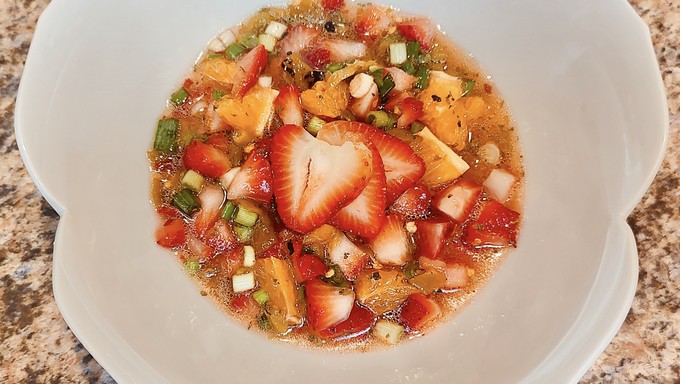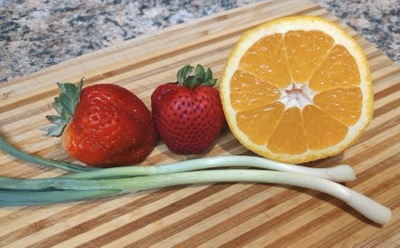
Recipe: Fresh strawberry-orange salsa with green onions

Fresh strawberries combine with oranges and chilies for a fruity spring salsa Debbie Arrington
What would Cinco de Mayo be without salsa? A lot less flavorful.
But this Mexican-inspired celebration falls in early May – long before fresh tomatoes are ripe in Northern California. Instead of basic tomato-based salsa, try this fruity alternative using two spring favorites: Strawberries and oranges.
Combined with fresh green onions (another spring favorite), the berries and citrus add a hint of sweetness along with a juicy crunch.
Versatile as well as colorful, this fruity salsa pairs well with pork, chicken, shrimp or cheese enchiladas, tacos or quesadillas. Also use it to top grilled pork chops or pork tenderloin or dress up a chicken breast.
Or just grab some tortilla chips and dig in.
Strawberry-orange salsa
Makes about 1 cup
Ingredients:
1 orange
½ cup fresh strawberries, hulled and chopped

3 tablespoons green onions, chopped
1 tablespoon mild green chilies, diced
1 tablespoon cilantro, chopped
1 tablespoon rice vinegar
1 tablespoon extra virgin olive oil
½ teaspoon red chile flakes
½ teaspoon sugar
¼ teaspoon garlic salt
Instructions:
Cut the orange in half. Peel and chop one half of the orange; reserve the other half.
In a medium bowl, combine chopped orange, strawberries, green onions, chilies and cilantro. Lightly toss.
Into a small bowl, squeeze juice of remaining orange half. To orange juice, add rice vinegar, olive oil, chile flakes, sugar and garlic salt; mix. Add to the fruit-onion mixture. Lightly toss.
Refrigerate, covered, until ready to use.
Comments
0 comments have been posted.Sacramento Digs Gardening to your inbox.
Sites We Like
Garden Checklist for week of July 21
Your garden needs you!
* Keep your vegetable garden watered, mulched and weeded. Water before 8 a.m. to reduce the chance of fungal infection and to conserve moisture.
* Feed vegetable plants bone meal, rock phosphate or other fertilizers high in phosphate to stimulate more blooms and fruiting. (But wait until daily high temperatures drop out of the 100s.)
* Don’t let tomatoes wilt or dry out completely. Give tomatoes a deep watering two to three times a week.
* Harvest vegetables promptly to encourage plants to produce more. Squash especially tends to grow rapidly in hot weather. Keep an eye on zucchini.
* Pinch back chrysanthemums for bushy plants and more flowers in September.
* Remove spent flowers from roses, daylilies and other bloomers as they finish flowering.
* Pinch off blooms from basil so the plant will grow more leaves.
* Cut back lavender after flowering to promote a second bloom.
* It's not too late to add a splash of color. Plant petunias, snapdragons, zinnias and marigolds.
* From seed, plant corn, pumpkins, radishes, winter squash and sunflowers.